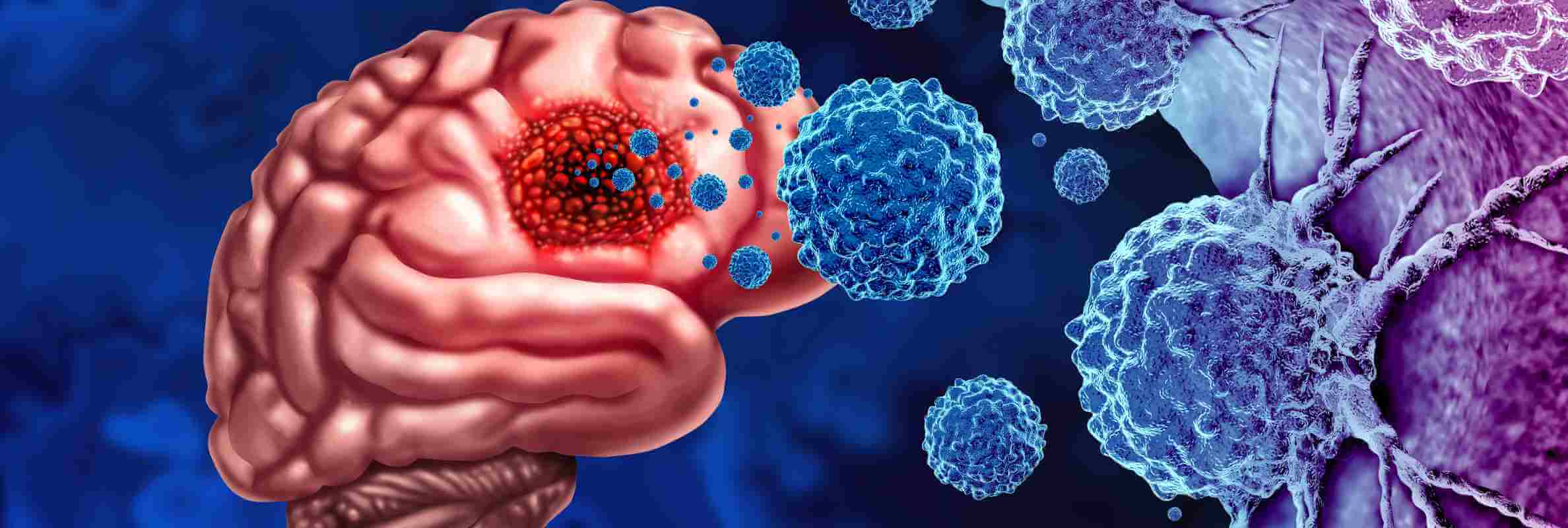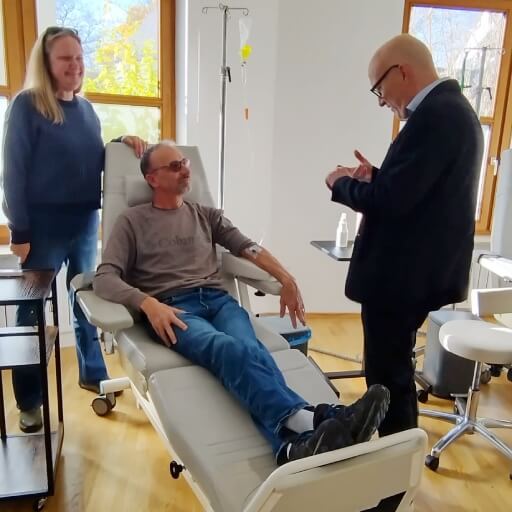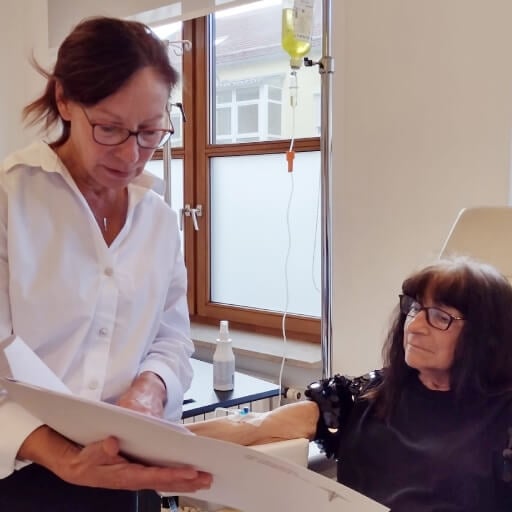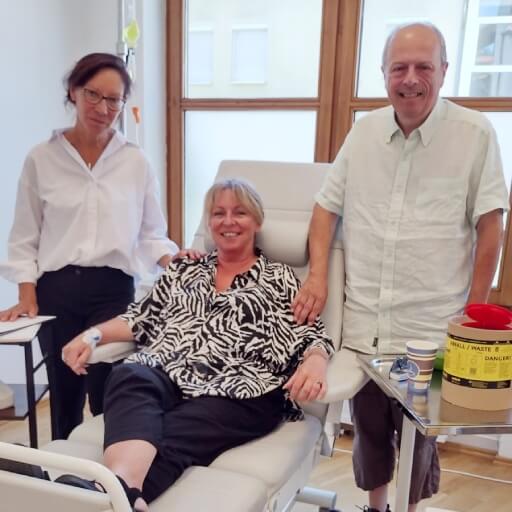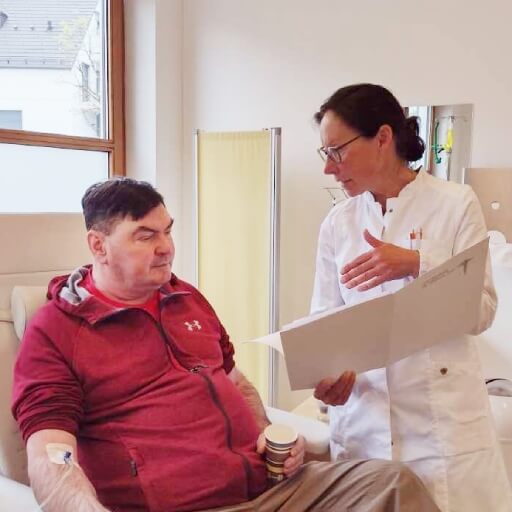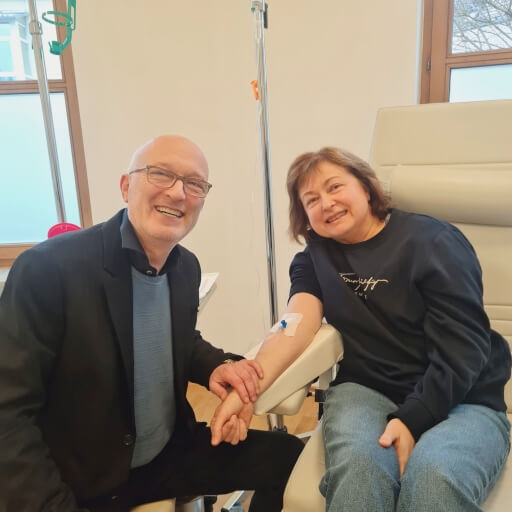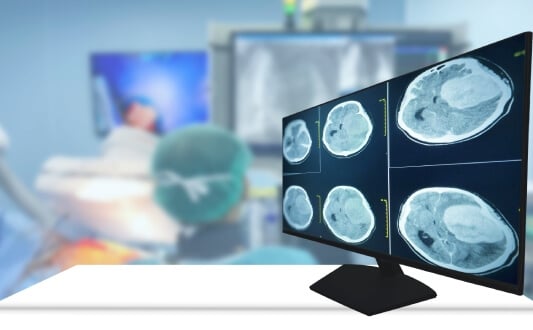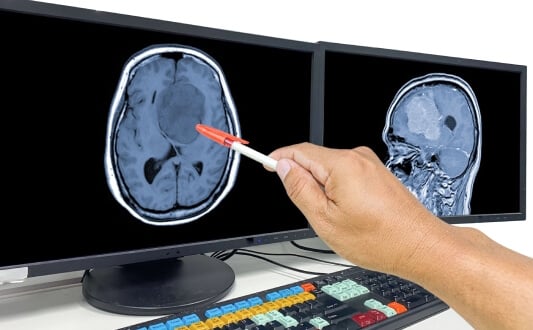This is scary and confusing when one gets the glioblastoma (GBM) diagnosis. But innovative therapies are changing outcomes for patients worldwide. This guide provides you with information on conventional protocols and breakthrough medical care. You need to understand all available options to make informed decisions. Our team helps connect patients with the best doctors and the glioblastoma newest treatment regardless of location. With expert caregiver support, patients can focus entirely on what matters most – their recovery and well-being.
An Overview of Glioblastoma
The most aggressive primary brain cancer is glioblastoma multiforme (GBM), as according to statistical data.It is rare at 3.2 cases per 100,000 people annually [1] but accounts for nearly 48% of all brain malignancies [2]. Historical survival statistics indicate only 40% survival after 1 year post-diagnosis but these numbers are rapidly improving as new treatments for glioblastoma become available.
New glioblastoma multiforme treatments are dendritic cell immunotherapy, laser interstitial thermal therapy (LITT) and advanced interventional radiology. The patient care at top international centres offers targeted therapies not available in many local hospitals. Some specialised centres work with support groups that provide medical and emotional support.
These dramatic differences in standard versus specialized care indicate the need to seek treatment at centers experienced in both conventional and novel therapies. With proper support patients may find these new advanced treatment options for glioblastoma opening new horizons for better prognosis and quality of life.
Glioblastoma Standard Treatment Protocols
A multimodal approach combining surgery, radiation therapy and systemic medications is the basis of glioblastoma management. This integrated strategy typically offers patients better results than single glioblastoma treatment options. Hovewer, standard treatment for glioblastoma remains an essential component of therapeutic regimens.
Surgical Interventions for Glioblastoma
Neurosurgery constitutes the core of treatment for glioblastoma multiforme and aims to remove as much tumor as safely for the neurological function as possible. Surgeons use such advanced techniques:
- Surgery with fluorescence guidance
- Intraoperative brain imaging
- Brain mapping techniques
- Navigational technologies
Clinical trials suggest that patients with more complete tumor resections report generally better quality of life and longer survival times. Then comes radiation and chemotherapy for remaining cancer cells.
Radiation Therapy Approaches for Glioblastoma
Following surgery, radiation treatment for glioblastoma destroys microscopic cancer cells that remain, offering:
- Precise targeting using advanced imaging to create a plan of the best treatment for glioblastoma that conforms to tumor contours while sparing critical brain structures
- Image-guided delivery ensures each treatment session precisely matches the original plan
- A standard treatment course for patients under 70 with good health status involves daily treatments over six weeks
- A combined approach with oral chemotherapy significantly extends survival compared to radiation alone
For recurrent glioblastoma, stereotactic radiosurgery is an option when surgical intervention isn't possible. This approach delivers concentrated radiation to tumor areas in one or a few sessions, without surgery.
Throughout treatment of glioblastoma multiforme, radiation oncologists work to balance maximum tumor control with preservation of brain function.
Proton Therapy for Glioblastoma
Today proton therapy represents one of the most sophisticated radiation therapy approaches. And unlike conventional radiation that hits the entire brain, proton therapy has special physical properties that make it useful for the treatment for glioblastoma brain cancer [5].
Proton therapy for glioblastoma has the key advantage – which is precision delivery:
- Bragg peak phenomenon forces protons to concentrate their energy near the tumor site and away from healthy brain tissue
- Reduced "exit dose" means radiation stops at the tumor rather than entering the brain
- Highly conformal treatment produces steep dose gradients between the tumor and normal tissue
For glioblastoma patients, these characteristics suggest a few possible benefits:
- Healthy brain tissue is exposed to less radiation
- The risk of treatment-related side effects is lower
- Dose escalation without an increase in toxicity is possible
Current translational research comparing outcomes between proton and conventional radiation suggests comparable tumor control with potentially better quality of life especially in younger patients and patients requiring recurrent glioblastoma treatment.
Chemotherapy and Targeted Medications for Glioblastoma
Oral chemotherapy drugs are the main drug treatments for glioblastoma. Combined chemoradiation and treatment improve survival over either treatment alone. The standard way to do it is taking pills every day during the six weeks of radiation and about six months after that as the maintenance therapy.
There are newer targeted therapy options now. They go after specific problems in each person's tumor. These latest treatments target genetic mutations or overactive pathways that make the tumor grow:
- Some drugs block the signals that tell cancer cells to grow and divide
- Other drugs stop cancer cells from dividing completely
- Some blockers mess with the internal communication that cancer cells need
The ongoing research of glioblastoma cancer treatment focuses on identifying which patients will benefit most from specific therapies; the decisions are made based on the tumor's unique molecular profile.
Innovative Approach: Dendritic Cell Therapy for Glioblastoma
While treatment of glioblastoma often fails to avoid recurrence, a pioneering approach is changing the outlook by using the body's defense mechanisms. Dendritic cell therapy is one of the most promising choices among immunotherapy for GBM that offers many advantages with less unwanted side effects compared to standard methods.
Exactly How Dendritic Cell Therapy for Glioblastoma Works
The immune system identifies and also eliminates threats through the body. Dendritic cells function as important sentinels in this technique – whenever they neglect to work right, the body's immune system can't recognize pathogens, making the body susceptible to malignant and infectious illnesses, including glioblastoma.
This essential immune mechanism was recognized worldwide when Ralph M. Steinman received the 2011 Nobel Prize in Physiology or Medicine for his discovery of dendritic cells and their critical role in immune function.
The dendritic cellular treatment for glioblastoma harnesses patients' very own immune components. These cellular "security guards" undergo laboratory processing to improve their ability to identify brain cancer cells, offering a number of key advantages:
- Selective targeting: Dendritic cell therapy activates immune responses specifically against glioblastoma cells while leaving healthy brain tissue untouched, unlike radiation and chemotherapy, which affect equally non-cancerous and cancerous cells.
- Evolving immune response: This approach generates immune reactions which can set to cancer mutations over time, dealing with the prevalent problem of treatment resistance.
- Sustained immune activity: Unlike conventional stage four or maybe stage 3 glioblastoma treatment, and that works just during the treatment phase, dendritic cell vaccination generates an immune response which continues operating long after administration.
- Reduced treatment burden: Patients usually experience fewer negative effects with dendritic cell therapy as opposed to the substantial side effects related to regular radiation and chemotherapy regimens.
- Enhanced brain tumor access: The activated dendritic cells are able to pass the defensive blood brain barrier, unlike standard cancer medicines, that can't efficiently reach brain tumors.
Glioblastoma Patient Selection Criteria
Dendritic cell vaccine for glioblastoma is more often part of a complex treatment program than a single therapy:
- Pre-surgical application in selected patients to reduce tumor size and potentially improve surgical outcomes
- Post-surgical treatment is used to combat microscopic cancer cells that remain after surgery and via that prevent recurrence
- Nonsurgical treatment option is used in patients who cannot undergo surgery; dendritic cell therapy may help manage disease progression. This also is an option for the recurrent disease.
Newer clinical research supports this innovative strategy. A landmark 2023 Phase III study reported in Translational Cancer Research showed better survival rates in GBM patients following dendritic cells vaccination. The most striking results occurred in patients with particular genetic features such as promoter MGMT methylation that were significantly better than controls [3]. Especially encouraging were the results when combining dendritic cell therapy with tumor-treater fields technology in recurrent disease patients.
Fighting Glioblastoma with Dendritic Cells: Prof. Gansauge Explains
Innovative Approach: Interventional Radiology Techniques for Glioblastoma
Less invasive interventional radiology procedures constitute virtually the best alternative treatment for glioblastoma and pose less threat to critical brain structures. These are especially helpful for tumors in sensitive or deep brain regions.
Embolization for Glioblastoma
Tumor blood supply reduction techniques can manage highly vascular glioblastomas and are mostly performed before surgery. Interventional radiologists guide thin catheters through the vascular system to vessels feeding the tumor and introduce materials that block those vessels. This preparation lowers bleeding risks after tumor removal.
Most embolization procedures use specialized imaging known as angiography to visualize the blood supply network to the tumor. Materials used to block vessels include particles, specialized coils or liquid embolic agents that harden upon contact with blood. It is performed 24-48 hours before planned surgery to achieve maximum blood flow reduction without forming new collateral vessels.
Studies show that pre-surgical embolization can significantly decrease intraoperative blood loss by up to 50% in highly vascular glioblastomas, allowing surgeons to achieve more complete tumor removal with improved visibility of tumor boundaries.
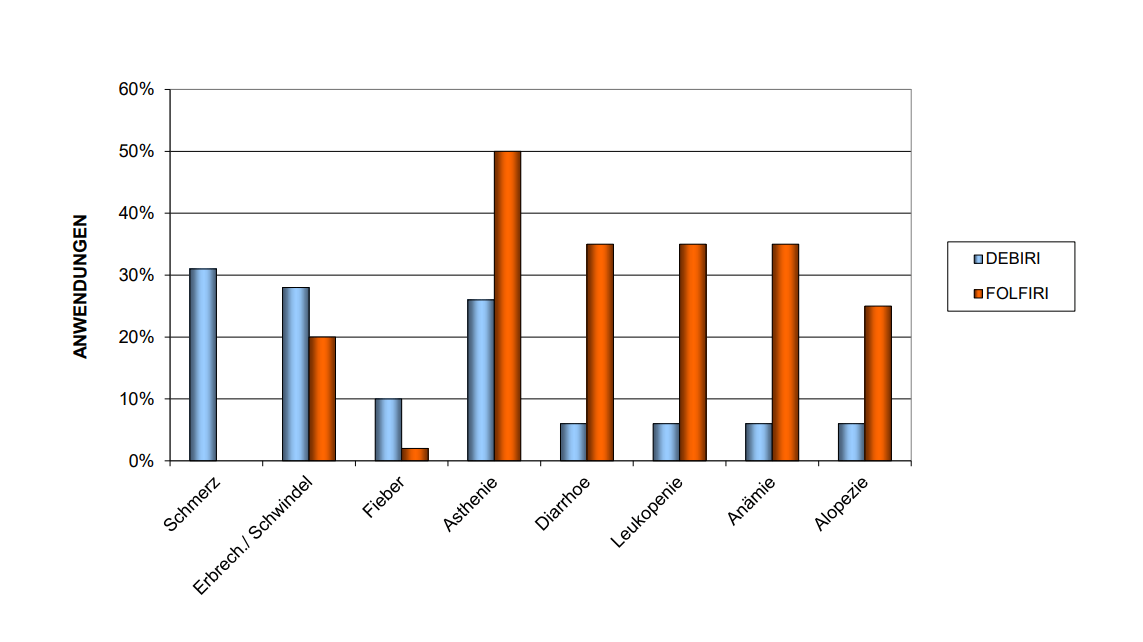
**DEBIRI = TACE, FOLFIRI = IV therapy; with DEBIRI, 90% of the patients have improved quality of life for 32 weeks
Electrochemotherapy for Glioblastoma
Electrochemotherapy involves electrical pulses combined with cancer fighting medications to improve treatment of glioblastoma. Some advantages this GBM new treatment may offer are as follows:
- Specialized electrodes deliver short electrical pulses into the tumor area via a tiny skull opening
- Electricity temporarily opens up cell membranes, enabling drugs to enter tumours 300 times more effectively
- The effect of GBM treatment remains localized and minimally damaging to adjacent healthy brain tissue
- The procedure can be performed quickly in one session – possibly during surgery
Laboratory studies show promising results, with complete tumor elimination in approximately 70% of treated subjects. The controlled, localized tissue effects gradually resolve as treated areas are replaced by fluid-filled spaces through natural healing processes. This approach may offer particular value for patients with tumors in deep or eloquent brain regions where conventional surgery carries excessive risk.

Laser Interstitial Thermal Therapy for Glioblastoma
Laser interstitial thermal therapy (LITT)/laser ablation offers new hope to patients that can not undergo conventional tumor removal [4]. It employs magnetic resonance guidance to place a targeted laser inside the tumor. The laser produces controlled heat energy that destroys cancer cells while real-time monitoring protects surrounding healthy tissue.
In studies by Cleveland Clinic researchers, this strategy achieves similar survival as biopsy followed by radiation and chemotherapy in newly diagnosed glioblastoma patients who are unsuitable for traditional surgery. Ideal results are usually seen in smaller tumours (under 11cc) and in younger patients (under 70).
Amazingly, heat from LITT can temporarily break the blood brain barrier, improving the absorption of subsequent GBM treatments into the tumor. With regard to recurrent glioblastoma, laser treatment provides about 11.5 months of survival benefit after the procedure – an important consideration with few therapeutic options available for recurrent disease.
Prof. Kovács: How Electrochemotherapy Became the Gold Standard for Hard-to-Reach Tumors
Comparative Analysis of Standard & Innovative Treatments for Glioblastoma
When evaluating treatment options it is better to understand a new treatment for glioblastoma compared to standard protocols. This informs patients & doctors about best practices. Analysis takes into account effectiveness / side effects / quality of life impact / accessibility issues.
| Treatment Approach | Response Rate | Survival Benefit | Side Effects | Treatment Duration | Treatment Cost Range (Europe) | Access to care |
|---|---|---|---|---|---|---|
| Surgery | 60-80% (early stages of glioblastoma) 20-30% (advanced) | Foundation for other treatments | Pain, infection risk, and recovery time | One-time procedure | €25,000 - €50,000 | Widely available |
| Conventional Radiation | 40-60% (early) 15-20% (advanced) | Part of the standard protocol | Fatigue, skin irritation, cognitive effects | 6 weeks (daily sessions) | €28,000 - €42,000 | Available at most brain cancer centers |
| Proton Therapy | 50-70% (early) 15-25% (advanced) | Similar to conventional radiation with reduced side effects | Mild to moderate | 6 weeks (daily sessions) | €56,900 - €90,500 | Limited to specialized centers |
| Dendritic Cell Therapy | 85-95% (early) 60-80% (advanced) | Potential for long-term survival benefit | Minimal (primarily flu-like symptoms) | One-time procedure with lasting effects | €20,000 - €38,000 | Available at specialized centers |
| Electrochemotherapy | ~70% complete response in studies | 9-14 months median survival improvement | Localized effects, minimal systemic impact | Single session | €30,000 - €45,000 per treatment course | Highly specialized, limited availability |
| Laser Interstitial Thermal Therapy | Best for tumors under 11cc | ~11.5 months for recurrent disease | Minimal | One-time procedure | Part of the surgical costs | Limited to advanced centers |
*Booking Health data. How well treatments work and how long patients survive depends a lot on each person's specific situation.
The cost of glioblastoma treatment can vary significantly. The price will depend on the following factors:
- Hospital location
- Treatment program
- Duration of therapy
A standard treatment program usually has a lower price than a comprehensive glioblastoma management strategy. However, it is not the case of compromising survival and quality of life for the sake of price reduction. In addition, many international hospitals have fees for international patients, which may significantly increase costs. Noteworthy, utilizing Booking Health services guarantees the absence of any fees for patients from abroad, which helps to save up to 60% of treatment cost. In addition, prices for innovative therapies can vary due to the different availability of these methods in various countries, as well as the complexity of the legislative approval process. Consequently, the same novel approach for glioblastoma multiforme may be more expensive in the USA, but more affordable in Germany. The overview of both primary and recurrent glioblastoma treatment cost is summarized in a table below.
| Treatment Method | Germany | GB | USA |
|---|---|---|---|
| Standard Treatment | €80,000 - €150,000 full course | €90,000 - €165,000 full course | €100,000 - €180,000 full course |
| Innovative Methods | €25,000 - €60,000 full course | €70,000 - €120,000 full course | €100,000 - €150,000full course |
Glioblastoma Patient Success Stories
Patient experiences provide the most compelling evidence of treatment effectiveness. Daria Rogers' medical travel illustrates how innovative treatments can transform expected outcomes.
Daria was diagnosed with glioblastoma multiforme in her early 50s, that happened after she had had a seizure . Despite successful surgical tumor removal, her doctor delivered the devastating news that standard treatments typically provide just 12-15 months of life expectancy with no long-term survival at all.
"The diagnosis devastated us completely," Daria says. "While I was still recovering, my husband Maurice began searching for additional options beyond what was available in our home country."
They found out about dendritic cell immunotherapy that you could get for glioblastoma treatment in Germany, and they worked with an international Booking Health patient assistance to help them set up the treatment just three weeks after Daria's first surgery.
"In Germany, glioblastoma treatment was surprisingly straightforward," Daria explains. "They collected my blood, administered supportive treatments, and prepared my personalized vaccine in their laboratory. The entire procedure was comfortable and produced no negative effects."
When Daria got back to Ireland, she did the regular radiation and chemo. "I'm convinced the immunotherapy for GBM in Germany helped me tolerate the standard treatments remarkably well. Despite undergoing daily radiation treatments 5 times weekly, I maintained my energy and experienced minimal side effects."
Three months after radiation ended, she got MRI / CT scans with even better news – no sign the tumor came back. They did more scans in October 2024 and still no recurrence.
The Rogers family says getting specialized help was really important because "When facing this diagnosis, even basic daily tasks become overwhelming. Having professional assistance with medical arrangements made accessing this life-changing treatment possible."
Treatment Options for Advanced Glioblastoma and Glioblastoma Recurrence
Despite all the advances in treatment, many glioblastoma patients will have their tumor return or worsen. It means you need a personalized treatment based on where the tumor is located, what treatments you received, your health, the tumor's molecular profile, etc.
Several approaches are considered for recurrent disease:
- Additional surgery when safely possible
- Carefully targeted reirradiation treatments
- Immunotherapy, dendritic cell vaccination
- Alternative treatments for glioblastoma
- Minimally invasive options like LITT and TACE
Glioblastoma stage 4 treatment is complicated; specialized guidance may improve treatment outcomes by shifting beyond standard care to potentially lifespan-extending novel approaches. The end goal is to provide each patient with the best treatment for their situation through brain tumor specialists with experience and knowledge.
International medical tourism facilitator Booking Health simplifies this by connecting patients with the best hospitals for glioblastoma worldwide. Patients get individualized treatment plans from top glioblastoma experts and priority appointments at advanced treatment centers. This broad support enables patients to concentrate on their health and not logistics, while obtaining the most advanced treatments worldwide at a low cost for glioblastoma treatment.
Best Hospitals for Glioblastoma
The table below presents a list of hospitals that are considered to be among the best glioblastoma treatment in the world.
| Hospital | Expertise |
|---|---|
| University Hospital Rechts der Isar Munich | Specializes in neuro-oncology, focusing primarily on stereotactic and image-guided radiotherapy |
| University Hospital of Ludwig Maximilian University of Munich | Lead research on neuro-oncology and has a specialized brachytherapy unit |
| Helios Hospital Berlin-Buch | A major interdisciplinary cancer center and certified oncology hub |
| Schoen Klinik Rendsburg | Experts in spinal neurosurgery and neurological rehabilitation |
| University Hospital Regensburg | Leading experts in neuro-oncology and brain surgery |
The University Hospital Rechts der Isar Munich is, by some estimates, the best hospital for glioblastoma treatment. It is among leaders in imaging technologies and neuro-oncology with a special focus on stereotactic and image-based radiotherapy. Its novel techniques make it a top destination among glioblastoma multiforme treatment centers worldwide.
The University Hospital of Ludwig Maximilian University of Munich is renowned for their groundbreaking research work in the field of oncology, including brain tumors. The glioblastoma specialists at this university hospital cover various radiation therapy modalities, including proton therapy. This contributes to the high authority of the facility among the best glioblastoma treatment centers specializing in cancer radiotherapy. In addition, the hospital has a separate brachytherapy unit, making it a desired destination for patients seeking brain cancer treatment, including for glioblastoma multiforme.
The Helios Hospital Berlin-Buch is a major multidisciplinary medical center and a certified oncology hub. The specialists at this center ranked among the top glioblastoma treatment centers, are experts in multimodal therapy utilizing chemotherapy, immunotherapy, hyperthermia, and targeted therapy to deal with cancer. Having one of the most skilled neurosurgery teams, the Helios Hospital Berlin-Buch performs hundreds of minimally invasive brain tumor resections annually, making it one of the best brain cancer hospitals in the world.
The Schoen Klinik Rendsburg is a major multidisciplinary center, which provides advanced care for patients with brain tumors. As experts in spinal neurosurgery, this medical hub welcomes patients with spinal tumors from all Germany. Glioblastoma cancer specialists collaborate with the radiology unit and neuroimaging team to provide the best brain cancer treatment in the world. Their expertise in neurorehabilitation allows them to provide enhanced and high-quality rehabilitation after treatment.
The University Hospital Regensburg is a leading medical institution with expertise in brain tumor surgery. The application of neuronavigation techniques and functional mapping helps maximize tumor volume resection while preserving neurological functions. The university hospital is also actively participating in clinical trials, which gives the patients an opportunity to get in touch with the latest promising innovations in brain tumor management.
Rating for the best brain tumor hospital in the world is constantly changing. Novel technologies, imaging techniques, and breakthrough treatments are emerging continuously, which reshapes glioblastoma management day-to-day. Germany has always been at the forefront of brain cancer treatment due to the active implementation of the top-notch technologies and its dedication to research. Germany offers a choice among the best treatment center for glioblastoma and novel approaches to glioblastoma treatment and makes these medical innovations available to international patients.
Timely Glioblastoma Management with BH
Finding the best treatment strategy for your clinical situation is a challenging task. Being already exhausted from multiple treatment sessions, having consulted numerous specialists, and having tried various therapeutic interventions, you may be lost in all the information given by the doctors. In such a situation, it is easy to choose a first-hand option or to follow standardized therapeutic protocols with a long list of adverse effects instead of selecting highly specialized innovative treatment options.
To make an informed choice and get a personalized cancer management plan, which will be tailored to your specific clinical situation, consult medical experts at Booking Health. Being at the forefront of offering the latest medical innovations for already 12 years, Booking Health possesses solid expertise in creating complex cancer management programs in each case. As a reputable company, Booking Health offers personalized glioblastoma treatment plans with direct clinic booking and full support at every stage, from organizational processes to assistance during treatment. We provide:
- Assessment and analysis of medical reports
- Development of the medical care program
- Selection of a suitable treatment location
- Preparation of medical documents and forwarding to a suitable clinic
- Preparatory consultations with clinicians for the development of medical care programs
- Expert advice during the hospital stay
- Follow-up care after the patient returns to their native country after completing the medical care program
- Taking care of formalities as part of the preparation for the medical care program
- Coordination and organization of the patient's stay in a foreign country
- Assistance with visas and tickets
- A personal coordinator and interpreter with 24/7 support
- Transparent budgeting with no hidden costs
Health is an invaluable aspect of our life. Delegating management of something so fragile yet precious should be done only to experts with proven experience and reputation. Booking Health is a trustworthy partner, who assists you on the way of pursuing stronger health and better quality of life. Contact our medical consultant to learn more about the possibilities of personalized treatment with innovative methods for glioblastoma with leading specialists in this field.
Advanced Cancer Treatment: Patient Success Stories with Booking Health
Frequently Asked Questions About Glioblastoma Treatment
Send request for treatmentAs reported, median survival for glioblastoma is 14-18 months. Patients with biomarkers like MGMT methylation respond to therapy better. Beyond all doubt, new treatments improve the prognosis as well.
With respect to individual tumor biology, glioblastoma may develop silently for weeks or months. The rapid growth of this grade 4 tumor means most patients experience symptoms within 3-6 months of tumor formation.
If there is no treatment, glioblastoma typically leads to a significant decline within 3-4 months of diagnosis. In this period pain management is also important as untreated tumors create pressure in brain that leads to neurological degeneration.
There are about 3.2 cases per 100,000 people annually – almost 48% of all primary brain malignancies. It is a relatively rare malignancy compared to other cancers, but the most common in neuro-oncology practices worldwide.
A variety of tumors originating from glial cells in the brain are called glioma, and glioblastoma is a grade IV – aggressive type of tumor. Other gliomas include lower-grade tumors like astrocytoma which generally has better prognoses.
Rapid growth is typical for glioblastoma. Because they are unable to disappear without treatment, they double in size every 2-3 weeks. With this in mind, molecular testing may reveal growth rate influencing factors such as IDH mutation status that may help physicians predict tumor behavior.
The standard treatment includes maximal safe surgical resection; after that radiation with concurrent chemotherapy start. The adjuvant therapy continues for 6-12 months post radiation. It is better for patients to consult multidisciplinary teams of university hospitals or specialized centres.
Complete removal is challenging – glioblastoma invades beyond apparent tumor boundaries. Treatment abroad may mean access to specialized surgical approaches unavailable locally for complex tumors.
As reported, common side effects include fatigue, nausea, hair loss, cognitive changes from radiation, etc. We must also mention that non-invasive monitoring techniques help manage such effects early.
As mentioned in the article, these are dendritic cell therapy and interventional radiology techniques (embolization & electrochemotherapy). Precision medicine allows treatment tailoring to tumor characteristics; experimental protocols like CAR-T therapy and gene therapy are also promising.
In early disease, dendritic cell immunotherapy is promising with response rates of 85-95%. And so, alternative treatments like laser thermal therapy and electrochemotherapy are available. The best options often involve researching treatment abroad and confirming insurance coverage.
Treatment for glioblastoma typically includes surgery, radiation, and chemotherapy. Advanced methods are also used, because they can improve accuracy, reduce side effects, and extend survival. These methods include proton therapy, dendritic cell immunotherapy, electrochemotherapy (ECT), laser interstitial thermal therapy (LITT), and interventional radiology techniques.
Glioblastoma symptoms can vary by tumor location. However, they often include headaches, seizures, memory loss, speech or vision problems, personality changes, and weakness on one side of the body.
In general, response to glioblastoma treatment depends on the method and disease stage. For example, surgery can achieve 60-80% in early and 20-30% in advanced cases; proton therapy 50-70%; dendritic cell therapy up to 95% (early) and 60-80% (advanced); and ECT about 70%.
When treating glioblastoma, conventional radiation can cause fatigue and cognitive issues. On the other hand, the implementation of proton therapy can reduce these effects. Dendritic cell therapy usually causes only mild flu-like symptoms. In turn, ECT and LITT can lead to localized, short-term reactions.
In glioblastoma treatment, surgery and LITT are one-time procedures. On the other hand, radiation and proton therapy typically last six weeks. When it comes to dendritic cell therapy and ECT, these are performed in a single session.
As an innovative glioblastoma treatment approach, dendritic cell therapy can more than double five-year survival. In turn, ECT can potentially extend median survival by 9-14 months. On the other hand, proton therapy can help preserve cognitive function and quality of life.
Some of the most innovative therapies are offered in the following medical centers in Europe:
- University Hospital Muenster, Germany
- University Hospital HM Monteprincipe Madrid, Spain
- University Hospital for Neurosurgery Salzburg, Austria
- University Hospital of Ludwig Maximilian University of Munich
The cost of glioblastoma treatment can vary significantly depending on the hospital type, the treatment program (which is unique to each clinical case), and the therapy duration.
The rating of the best hospitals for glioblastoma treatment is based on their neuro-oncology programs, expert surgical teams with high volumes of cases, and access to clinical trials. The world's top hospitals for glioblastoma treatment include:
- Mayo Clinic (Rochester) – extensive brain tumor treatment experience combined with personalized medicine
- Memorial Sloan Kettering Cancer Center (New York) – renowned for translational glioma research and personalized therapy
- MD Anderson Cancer Center (Houston) – comprehensive cancer care with a dedicated neuro-oncology program
- University Hospital of Munich Ludwig Maximilian (LMU) – one of the best glioblastoma clinics in Germany
The so-called "success rates" for glioblastoma are not tracked in a centralized, global database due to variability in:
- Complex patient demographics and tumor biology
- Access to clinical trials
- Multidimensional nature of the definition of "success" (for example, progression-free vs. overall survival)
The top glioblastoma cancer specialists include:
- Dr. Mitchel Berger – Former Chair of the UCSF Neurosurgery who pioneered in glioma mapping
- Dr. Jörg-Christian Tonn – Specialist from the Ludwig Maximilian University of Munich (Germany) who leads clinical glioma surgery in Europe
- Dr. Behnam Badie – Specialist in the City of Hope and a Leader in CAR-T for brain tumors
- Dr. Patrick Wen – Specialist in Dana-Farber Cancer Institute (Boston) who plays a crucial role in clinical trial design for gliomas
- Prof. Karim Fizazi – Leading Oncologist at Gustave Roussy involved in brain metastases and glioma research
The top glioblastoma hospitals have the following features in common:
- Multidisciplinary care: apart from brain cancer treatments, they offer supportive care and rehabilitation after treatment
- Advanced surgical technology: intraoperative 3D MRI brain scans, 5-ALA fluorescence-guided resections, and awake surgeries
- High surgical volume: surgeons with >50-100 glioma cases per year have better outcomes
- Access to clinical trials: especially valuable for both newly diagnosed and recurrent glioblastoma
- Accreditation and certification: indicates high level of expertise in brain cancer care
Choose treatment abroad and you will for sure get the best results!
Authors:
This article was edited by medical experts, board-certified doctors Dr. Nadezhda Ivanisova, and Dr. Bohdan Mykhalniuk. For the treatment of the conditions referred to in the article, you must consult a doctor; the information in the article is not intended for self-medication!
Our editorial policy, which details our commitment to accuracy and transparency, is available here. Click this link to review our policies.
Sources:
[1] NIH, National Library of Medicine. Chapter 8 - Epidemiology and Outcome of Glioblastoma. https://www.ncbi.nlm.nih.gov/books/NBK470003/
[2] Grochans S, Cybulska AM, Simińska D, Korbecki J, Kojder K, Chlubek D, et al. Epidemiology of glioblastoma multiforme–literature review. Cancers (Basel). 2022;14(10):2412. doi:10.3390/cancers14102412 [DOI]
[3] Van Gool SW, Makalowski J, Kampers LFC, Van de Vliet P, Sprenger T, Schirrmacher V, et al. Dendritic cell vaccination for glioblastoma multiforme patients: has a new milestone been reached? Transl Cancer Res. 2023;12(5):1267-75. doi: 10.21037/tcr-23-603. [DOI]
[4] Montemurro N, Anania Y, Cagnazzo F, Perrini P. Survival outcomes in patients with recurrent glioblastoma treated with Laser Interstitial Thermal Therapy (LITT): A systematic review. Clin Neurol Neurosurg. 2020;195:105942. doi: 10.1016/j.clineuro.2020.105942. [DOI]
[5] Goliot N, Mohssine S, Stefan D, Leclerc A, Emery E, Riverain J, et al. Proton therapy for adult-type diffuse glioma: A systematic review. Crit Rev Oncol Hematol. 2024;104501. doi: 10.1016/j.critrevonc.2024.104501. [DOI]
Read:
Innovative Treatment for Glioblastoma in Germany: Dendritic Cell Therapy for Cancer
Article menu:
- An Overview of Glioblastoma
- Glioblastoma Standard Treatment Protocols
- nnovative Approach: Dendritic Cell Therapy for Glioblastoma
- Innovative Approach: Interventional Radiology Techniques for Glioblastoma
- Comparative Analysis of Standard & Innovative Treatments for Glioblastoma
- Glioblastoma Patient Success Stories
- Treatment Options for Advanced Glioblastoma and Glioblastoma Recurrence
- Best Hospitals for Glioblastoma
- Timely Glioblastoma Management with Booking Health
- Frequently Asked Questions About Glioblastoma Treatment
Don't know where to start?
Contact Booking Health